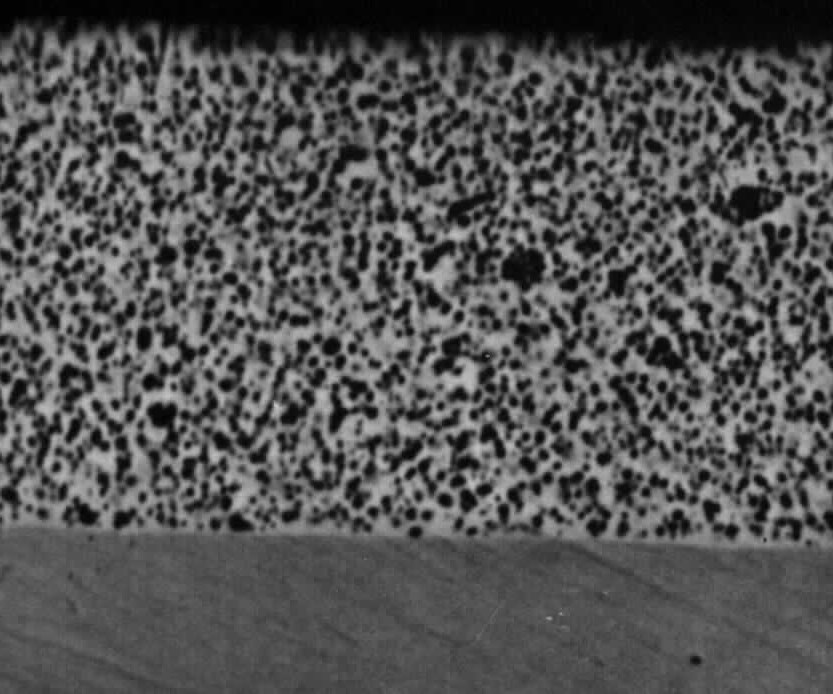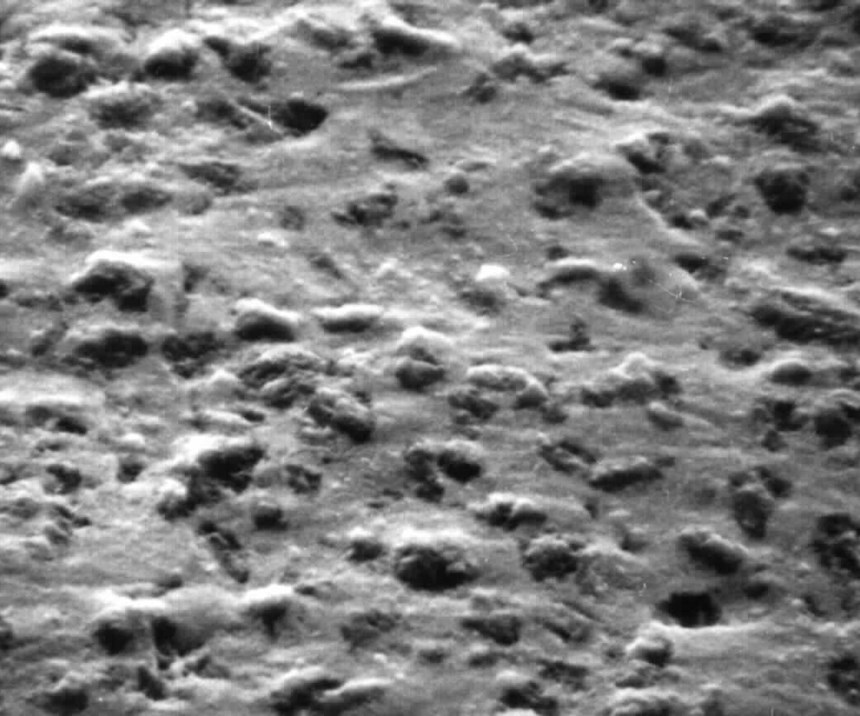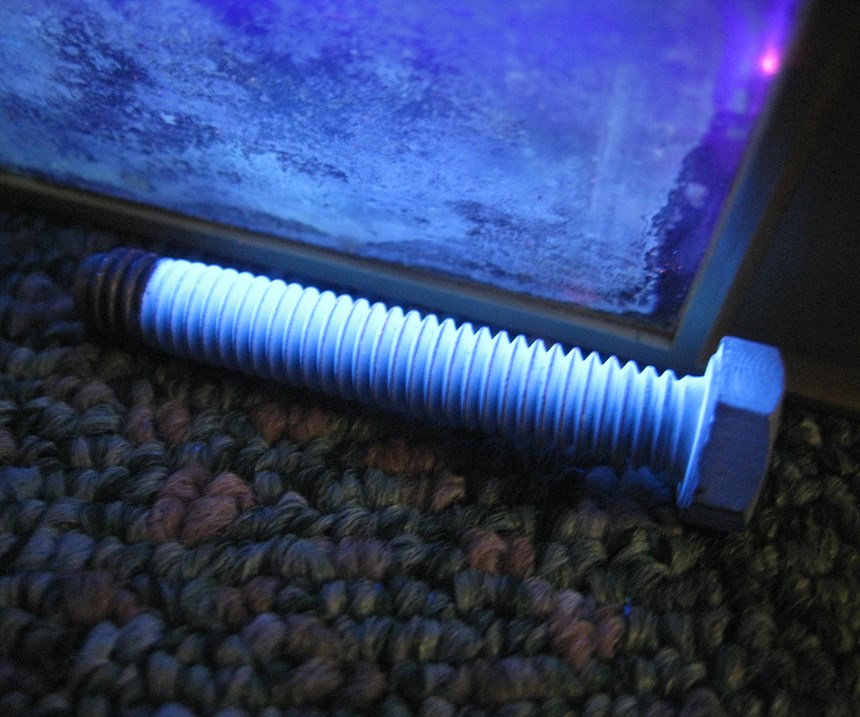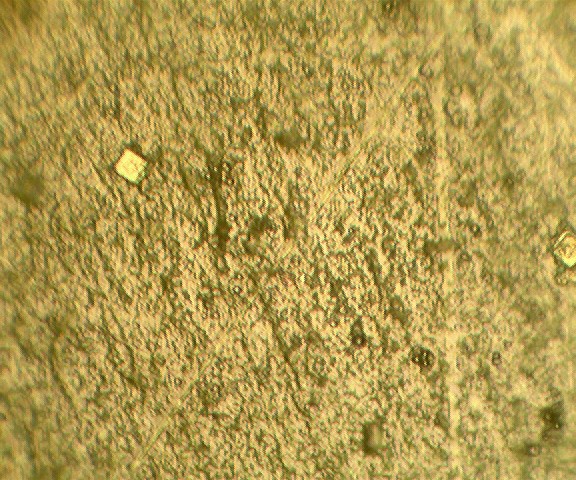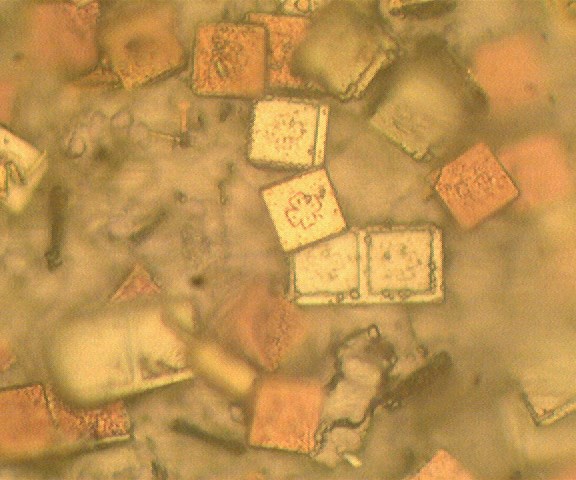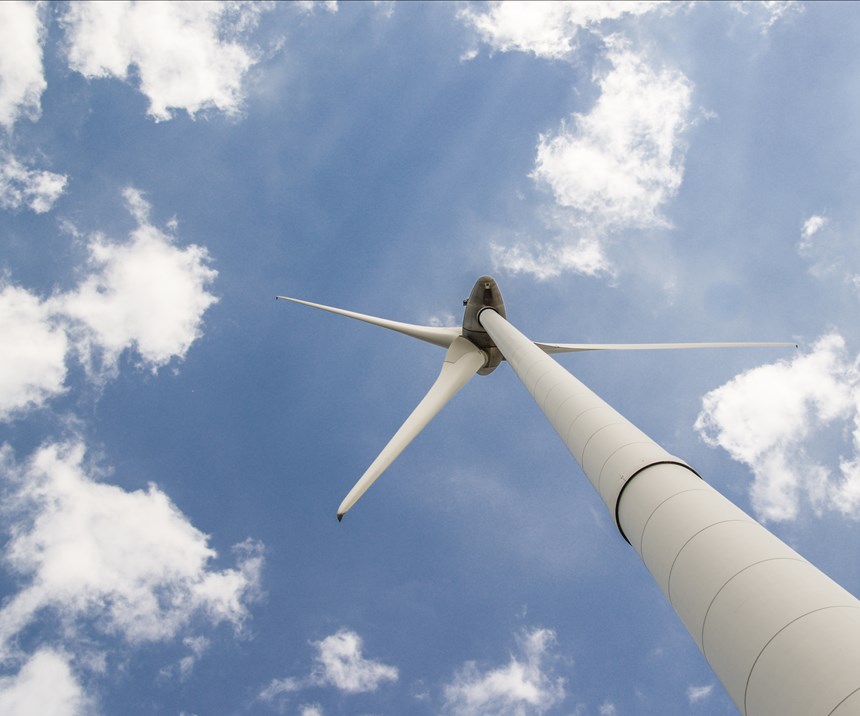Coatings can be advantageous and, in many applications, they are essential for proper performance, protection, lifetime and many other product qualities. Therefore, selecting the proper coating for each application is vital. Choosing the right coating for components used in the wind energy industry is especially challenging because those parts come in a tremendous array of shapes, sizes and base metals, and may be utilized in an equally exceptional range of climates, requirements and usage conditions.
One category of coatings that can enhance many applications in the wind industry is composite electroless nickel (CEN) plating. Electroless nickel (EN) is a sophisticated and reliable chemical process with many inherent features well suited to applications in the wind industry, including hardness, corrosion resistance and perfect conformity to even the most complex geometries. Composites are formed with the addition of superfine particles into the EN. These particles can provide hardness, wear-resistance, low-friction, release, heat-transfer, high-friction, and/or even identification and authentication properties.
This paper discusses all varieties of composite EN (CEN) that take advantage of the synergies between EN and particles to dramatically enhance existing characteristics and even add entirely new properties. This makes CEN coatings especially advantageous for applications in the wind industry to:
- Meet ever more demanding usage conditions requiring less wear, lower friction and heat transfer.
- Facilitate the use of new substrate materials, such as titanium, aluminum, lower cost steel alloys, ceramics and plastics.
- Allow higher productivity of equipment with greater speeds and less wear, maintenance efforts and downtime.
- Replace environmentally problematic coatings, such as electroplated chromium.
As shown in Image 1, CEN coatings will naturally maintain their properties and performance even as some portions of the coating may be worn or removed during use. This feature results from the uniform manner in which the particles are dispersed throughout the entire plated layer. Particles from a few nanometers up to about 50 microns in size can be incorporated into coatings from a few microns up to many mils (0.001 inch) in thickness. The particles can comprise approximately 10 to over 40 percent by volume of the coating, depending on the particle size and application.
Wear Resistance
Coatings designed for increased wear resistance have proven to be the most widely utilized CEN coatings in the wind industry to date. Particles of many hard materials such as diamond, silicon carbide, aluminum oxide, tungsten carbide and boron carbide can be used. But the unsurpassed hardness of diamond has made this material the most common composite. Despite the expensive-sounding name, CEN with diamond is actually comparable to the cost of similar coatings, yet the performance advantages are far greater. These coatings are also inherently beneficial to the environment as they make parts last longer, thereby reducing scrap and often saving energy.
The Taber Wear Test is the most common test method employed to evaluate wear resistance of different materials and coatings. It evaluates the resistance of surfaces to abrasive rubbing produced by the sliding rotation of two unlubricated, abrading wheels against a rotating sample. This test measures the worn weight or volume.
More practical and relevant than standardized test results are, of course, actual performance benefits experienced in real-life wind industry applications. In that regard, CEN coatings have the ability to make high-wear components last significantly longer and, thereby, reduce the need or frequency for maintenance or replacement. For a bearing, rotor, gear, housing and many other wind system components installed in very inconvenient locations in all sorts of environments on shore and offshore, the ability to extend their life is of exemplary value.
Heat Transfer and Low Friction
Diamond is not only the hardest known material, it is also the best heat conductor. Fortunately for wind energy components (where it is advantageous to draw heat away from the component), the incorporation of diamond in a CEN coating can provide this benefit as well. Prime examples are electrical components, heat sinks and any component operating in thinner atmospheres where heat transfer is compromised. In testing comparing aluminum to EN, CEN with diamond and CEN with carbide particles, the CEN with diamond yielded a 20 percent heat-transfer increase over aluminum.
Certain particles can be incorporated into EN to produce a coating with all the properties of EN as well as a low coefficient of friction. Although these composite coatings also provide wear-resistance benefits, they are considered in a separate category based on the unique characteristics they embody — dry lubrication, improved release properties and repellency of contaminants, such as water and oil.
Composite coatings with lubricating particles are generally in thicknesses of 6-25 microns (0.00025” to 0.001”), which is thinner than coatings typically designed for wear resistance. Most commercial interest in composite lubricating coatings has focused on the incorporation of submicron Teflon polytetrafluoroethylene (PTFE) particles into EN deposits. The properties of PTFE are widely recognized from industrial applications to frying pans.
But, as with wear-resistant particles, there are a variety of low-friction particles that produce self-lubricating properties when co-deposited into EN. Materials other than PTFE have become increasingly popular in the plating field, especially with certain specialty ceramics. PTFE is organic and decomposes at temperatures above 250°C. By contrast, many ceramic lubricating materials are harder and withstand higher temperatures than PTFE. As PTFE is a very soft material, its inclusion in EN makes the composite coating comparatively softer, especially as the percentage of PTFE increases. Higher temperature resistance permits higher post-plating, heat-treatment temperatures yielding greater hardness of the EN matrix.
These factors make the composite ceramic-lubricant coatings harder and more wear resistant than PTFE-EN in many conditions.
Table 1 shows the coefficients of friction for a variety of coatings under different load conditions. Boron nitride (BN) is one such inorganic material with lubricating properties. It has the ability to withstand temperatures up to 3,000°C depending on the atmosphere; and, as demonstrated in Table 1, composite EN with boron nitride has a lower coefficient of friction than composite EN-PTFE under higher load conditions. For the highly demanding components in the wind industry, the ability to apply thicker and harder CENs with materials such as BN are highly advantageous for both performance and service reliability.
High Friction and Indications
While many moving components in wind-energy equipment require low friction, others benefit from deliberately textured surfaces to allow friction or grip between mating surfaces. One example is assemblies with adjacent components where one engages with the other and transfers motion or breaking to the other. In such applications, a lightly textured surface can enhance this engagement. CEN coatings with a variety of carbides, oxides, diamond and other particles can provide this textured surface, as shown in Image 2 (where such particles can be seen protruding from the surface of the CEN coating). For such applications, the particles are sized from 10 to about 75 microns, which is significantly larger than the smooth coatings used primarily for wear resistance that employ particles less than 10 microns in size.
The following four sections show a variety of synergistic coatings with valuable identification and authentication properties for unique benefits in wind-industry applications.
Phosphorescence: One method to create coatings for authentication is to incorporate particles with light-emitting properties into EN coatings. These novel coatings appear like normal EN under traditional lighting (sun, incandescent, fluorescent and more), but under an ultraviolet (UV) light, these coatings emit a distinct brightly colored glow. A person simply needs to shine a hand-held, battery-operated UV light on parts to display the light emission of a composite EN coating and, thereby, confirm the authenticity of the parts. As there are a number of materials that fluoresce under UV light, it is possible to produce a variety of EN coatings that each give off a different color glow when a UV-light source is shined on the coating. This coating variety can also be used under a functional coating such as CEN to demonstrate wear to avoid damage to the part itself. With a thin layer of a light-emitting coating between the substrate and the functional coating, an operator may then inspect the part periodically with a portable UV light, often while the part is still in use. Once colored light is observed, it is known that the functional coating has worn away. The part can then be recoated and reused before substrate damage to the part itself occurs and before an inferior product is produced. In the wind energy industry, such a feature can be of tremendous value to allow inspection of a component without the cost of part removal and downtime.
Forensic Markers: While the composite phosphorescent EN coatings are a useful technology for many applications, other applications require an even greater need for covert authentication. This can be accomplished by the use of certain forensic markers, which are a family of materials that have been developed using unique substances and can be detected by an electronic meter. The test is noninvasive, instantaneous and infinitely repeatable. These materials are chemically inert, safe and strong enough to persist in almost any conditions, including an EN plating bath and heat treatment. Only small amounts of the ceramic-based materials need to be co-deposited into the EN coating to make their properties evident to the electronic meter. Therefore, the slight presence of the material in the coating is not readily visible and essentially does not affect the performance of the coating in other regards such as wear resistance, corrosion resistance and friction. There are dozens of such materials that can be used alone or in combination to create a unique marking or tracking system that can be embedded in almost any material or coating — from paints and powder coating to CEN. This creates many new opportunities for product management, manufacturing process and logistics control, inventory management, quality assurance and pollution control and authentication — all necessities in the global wind systems market.
Sound Activating: A further variety of authentication coating technology has been developed that actually allows the coating to activate a small detector that produces an audible report. This innovative technology is similar to using forensic markers because only a small quantity of specialized materials needs to be incorporated into the coating to trigger the detector response. The test is instantaneous and generates a clear pass or fail indication. The detector is small and battery operated for economy and convenience, which can be essential to the maintenance technicians and others in the wind energy industry.
Microtaggants: This variety of coating technology provides a fourth means of product authentication simply by inspection of the surface under magnification. A key to making this type of coating useful in authentication and product protection is that the microtaggants are manufactured by a complex, proprietary process. The ability to customize the microtaggants means that their design can be modified on a continual basis to thwart counterfeiters or incorporate product identification and tracking information right on the surface of the product within a hard and durable coating.
Multilayer Composite EN Solutions
Underlayers: When a degree of corrosion resistance is needed above the level already provided by a CEN coating (as is often the case in wind-energy equipment), it is routine to apply an underlayer to a part before it is coated with a CEN. This underlayer is most often a high-phosphorous alloy of EN. This provides a barrier layer for corrosion and the outward functional layer will still be the CEN for part performance.
Overcoating: This is a procedure often utilized for composite wear-resistant coatings. Composites containing particles (as discussed earlier) are smooth to the touch and sufficient for most applications. When the coating is intended to contact certain delicate materials, these protruding particles may be deleterious or require a break-in period of use to smooth the surface. A break-in period is a luxury that most applications in wind energy equipment cannot afford. So, instead of employing mechanical means to smooth the surface and operating a coated part for a less productive break-in period, an overcoat can be applied. For a CEN coating, an overcoat layer of only about 5 microns of conventional EN is sufficient to cover the composite surface and provide a new, smoother surface.
The performance requirements of components used in the wind-energy industry are exceptionally diverse. They range from wear resistance, low friction, high friction, heat transfer and authentication to identification. For this reason, the ability to tailor CEN coatings with an array of synergistic particles makes these coatings uniquely beneficial for applications in the wind-energy industry.
Michael Feldstein is president of Surface Technology. Visit SurfaceTechnology.com. This article was originally published in Wind Systems magazine. Used by permission. Visit windsystemsmag.com.
Related Content
How to Maximize Nickel Plating Performance
The advantages of boric acid-free nickel plating include allowing manufacturers who utilize nickel plating to keep up the ever-changing regulatory policies and support sustainability efforts.
Read MoreHow to Choose Between Sulfate and Chloride-Based Trivalent Chromium
There are several factors to consider when choosing between sulfate and chloride-based baths for trivalent chromium plating. Mark Schario of Columbia Chemical discusses the differences and what platers should keep in mind when evaluating options.
Read MoreLiquid Chrome Vs. Chromic Acid Flake
Contemplating how to continue offering chromic acid services in an increasingly stringent regulatory world? Liquid chrome products may be the solution you’re looking for.
Read MoreAn Overview of Electroless Nickel Plating
By definition, electroless plating is metal deposition by a controlled chemical reaction.
Read MoreRead Next
A ‘Clean’ Agenda Offers Unique Presentations in Chicago
The 2024 Parts Cleaning Conference, co-located with the International Manufacturing Technology Show, includes presentations by several speakers who are new to the conference and topics that have not been covered in past editions of this event.
Read MoreEducation Bringing Cleaning to Machining
Debuting new speakers and cleaning technology content during this half-day workshop co-located with IMTS 2024.
Read MoreDelivering Increased Benefits to Greenhouse Films
Baystar's Borstar technology is helping customers deliver better, more reliable production methods to greenhouse agriculture.
Read More


